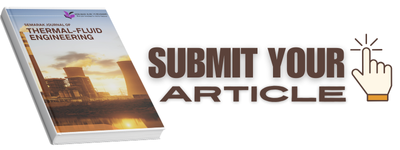Analysis of COVID-19 Aerosol Dispersion in a Car Cabin Due to Driver's Cough
DOI:
https://doi.org/10.37934/sjotfe.1.1.2333Keywords:
Coronavirus, coughing , flow characteristicsAbstract
The current coronavirus outbreak, attributable to SARS-CoV-2, has triggered widespread interest in the risk of infection associated with confined spaces. This study focuses on establishing a model for simulating the spread of COVID-19 within a car cabin due to a driver’s cough using computational fluid dynamics (CFD) simulation in the ANSYS Fluent software. Previous studies have mainly focused on the transmission of the virus over large areas; however, attention has shifted to confined areas, including cars. This study fills this gap by modelling the flow regions, velocity, and pressure fields of virus-containing aerosols. This includes constructing a three-dimensional model of a car cabin and visualising cough droplet movement. While tracking the dispersal of viral particles, the discrete phase model was applied with the stipulation of boundary conditions to mimic real-life coughing. The verification used in the study was a grid independence test, after which the simulations examined the particle residence time, streamline, and velocity field in the car. Studies have shown that viral particles can persist in the air for quite a while and circulate to various parts of the car cabin, thus putting the occupants at a higher risk of infection. The streamline analysis revealed possible propagation routes and recirculation zones that may amplify the transmission from the driver to the rest of the car occupants. The velocity distribution emphasises the potential exposure risk. The findings of this study corroborate previous research on the increased exposure of COVID-19car interiors, with particular emphasis on the transmission from the driver to the other occupants of the car. The outcomes of the research have drawn conclusions about the effectiveness of ventilation as well as other preventive measures to decrease the rate of airborne transmission in vehicles, thus responding to the objectives of the study.













